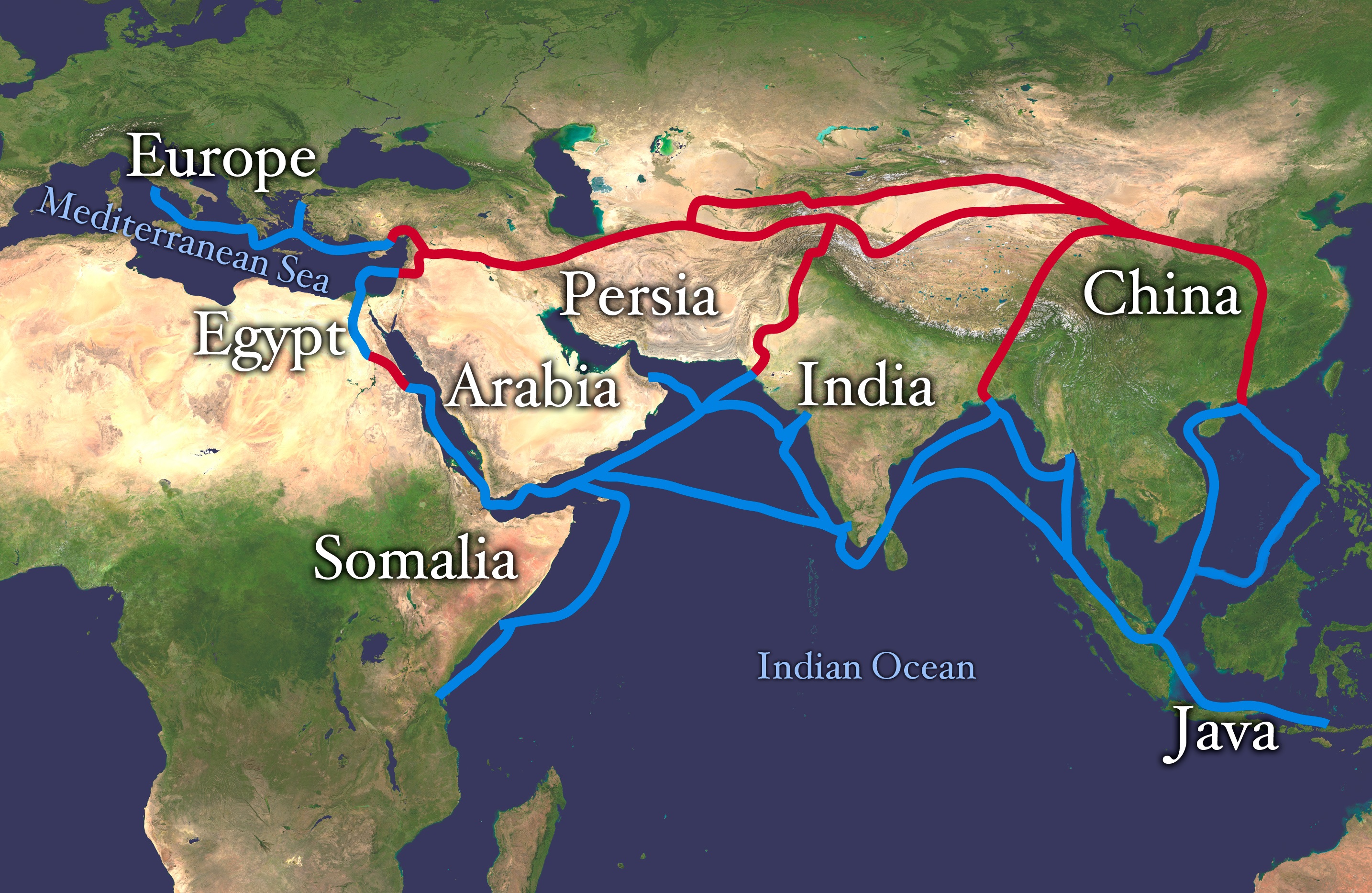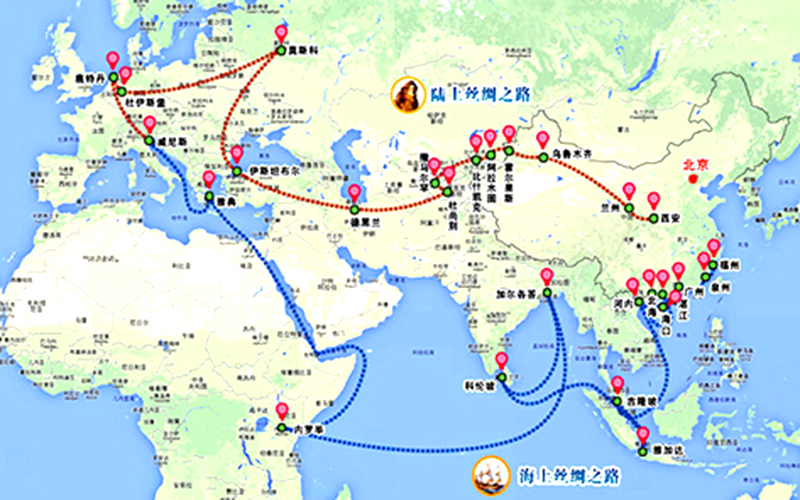Effects of the Silk Road on Classical India
Textiles spices and even religions were all exchanged along the Silk Road starting around 1000 BC. Peasants were able to bring up new agricultural commodities to Han society promoting the agricultural economy of Han.
Long Distance Trade Along The Silk Roads Silk Roads And The Fall Of Rome And Han
Fruits food plants animals and farming techniques exchange involved in the silk road trading enabled peasants from Han to acquire new skills and knowledge about farming and planting.

. Learning and the arts flourished supported by the thriving Gupta empire. How did geography affect the development of classical civilizations in India. Religious beliefs of the peoples of the Silk Road changed radically over time and was largely due to the effects of travel and trade on the Silk Road itself.
To understand what caused this trade in silk we need to look at how Chinese silk got to Rome. The demand for silk continued to drive trade between the Roman Empire China India and many places in between. The Silk Road Routes was a route that was established in order to increase trade of silk paper and other goods across China India and Central East Asia.
Coming back to the question-There was never any such thing called the Silk Road. Spices from the East Indies glass beads from Rome silk ginger and lacquerware from China furs from animals of the Caucasian steppe and slaves from many locations all. Known as the Silk Road this vast expanse of intercultural trade routes traversed Eurasia from the Mediterranean all the way to Japan crossing into India on the way.
What was the Indian Ocean Complex. Merchants on the silk road transported goods and traded at bazaars or caravanserai along the way. And continuing for several millenniums.
Strands of silk have been found in ancient Egypt from about 1000 BCE but these may be of Indian rather than Chinese origin. For over two thousand years the Silk Road was a network of roads for the travel and dissemination of religious beliefs across Eurasia. Different forms of music and the various instruments used to create it spread beyond its regions of origin accompanying people as they moved along the Silk Roads.
How did the Indian Ocean Complex affect the civilizations connected by it. Whilst the trade and travel there was a multicultural transmission between China and India. Effects of the Silk Road on Classical India 1 The Silk Road at first caused many pastoral groups to form.
The spread of diseases along the silk roads consisted of measles small pox and bubonic plague. The silk road was a network of paths connecting civilizations in the East and West that was well traveled for approximately 1400 years. Many merchants missionaries and travellers have used this road for traveling and trading from one end to another.
The Silk Road in World History Xinru Liu. The present study focuses on the trade links of India with ancient Silk Roads through Karakoram Pass in western Himalaya with two fold objective First to understand the cultural geography and traditional society of the western Himalaya which has been changed beyond expectation. It aided in the destruction of the Han and Roman empires and a massive population decrease ultimately resulting in temporary lack of productivity on the silk road.
The ancient Silk Road contributed greatly to the cultural exchange between China and the West. A The Silk Road provided employment opportunities across many civilizations as it was being constructed. Second documentation of common archaeological sites and monuments along the silk trade.
Because of traders travelling from both sides of the world to the opposite sides culture spread like wildfire. This involved many people and locations in the Silk Road trade networks. State Power and the Silk Road.
What were the long-term effects of the spread of disease along the silk roads. There were also cultural influences on both sides of the World. Han Emperor Wu sent imperial envoy Zhang Qian to.
There was a lot of spread and birth of religions on the Silk Road. The Silk Route derives its name from the lucrative trade in Chinese silk carried out along its length during ancient era. Indeed many musical instruments that were common in Silk Roads regions were very flexible.
What did exist was a collection of dozens if not hundreds of constantly-changing ill-regulated little-policed caravan routes stretching intermittently across most of Central Asia. Evidence of trade in ancient Chinese silk has been found in archaeological excavations in Central Asian Bactria currently the region around Balkh and Mazar-i-Sharif Afghanistan dating to about 500 BCE. From the second century BC to the fifteenth century AD splendid civilizations among China India Greece Persia and Rome were exchanged along this famous trade route making the route a great Cultural Bridge between Asia and Europe.
They traded goods such as silk spices tea ivory cotton wool precious metals and ideas. What historical circumstances led to the rise of classical civilizations in India. Architecture town planning as well as music and art from many different cultures were transported along the Silk Road.
2 The Silk Road allowed the spread of religions see chart above such as Nestorian ChristianityManichaeism Zoroastrianism and Buddhism. The Silk Road may have formally opened up trade between the Far East and Europe during the Han Dynasty which ruled China from 206 BC. How did the Silk Road contribute to the development of classical civilizations such as China Persia India and Arabia.
The New Silk Route and the effects on Indian Economy. The people traded luxury goods as well as ideas religions art culinary delicacies and musical traditions. The spread of papermaking was also influenced by the route.
The Silk Road was the worlds first great superhighway linking China and India to the Mediterranean world. Chandragupta relied on force while Asoka ruled by example. In turn those travelling along the Silk Roads absorbed the different musical influences of the regions in which they travelled.
One cause of expanded trade was the growth of imperial power. Travel was not only across Central Asia via caravans but also by water from the Mediterranean Sea to the South China Sea. This prohibition on silk did not last.
The religious beliefs of people along the Silk Road at the beginning of the 1st century BCE were very. B The Silk Road promoted a cultural exchange between China and the West and helped spread Chinese inventions. 3 The stirrup spread though out the Silk Road.
Gupta artisans produced goods sold locally and as far away as the Middle East and Southeast Asia. How did Chandraguptas and Asokas approaches to ruling differ. This production method spread from China through much of central Asia as a direct result of the route itself.
Eventually rich families did settleand build large establishments.

The Silk Road Article Khan Academy

How Big A Role Did Ancient India Play On The Silk Road Quora

The Silk Road Overland And Maritime Routes The Overland And Maritime Download Scientific Diagram
Slides And Notes For The Silk Road And Indian Ocean Trade Ii

The Dangers Of The Silk Road By Peter Last Name India Dictionary

India And The Silk Roads The History Of A Trading World By Jagjeet Lally

No comments for "Effects of the Silk Road on Classical India"
Post a Comment